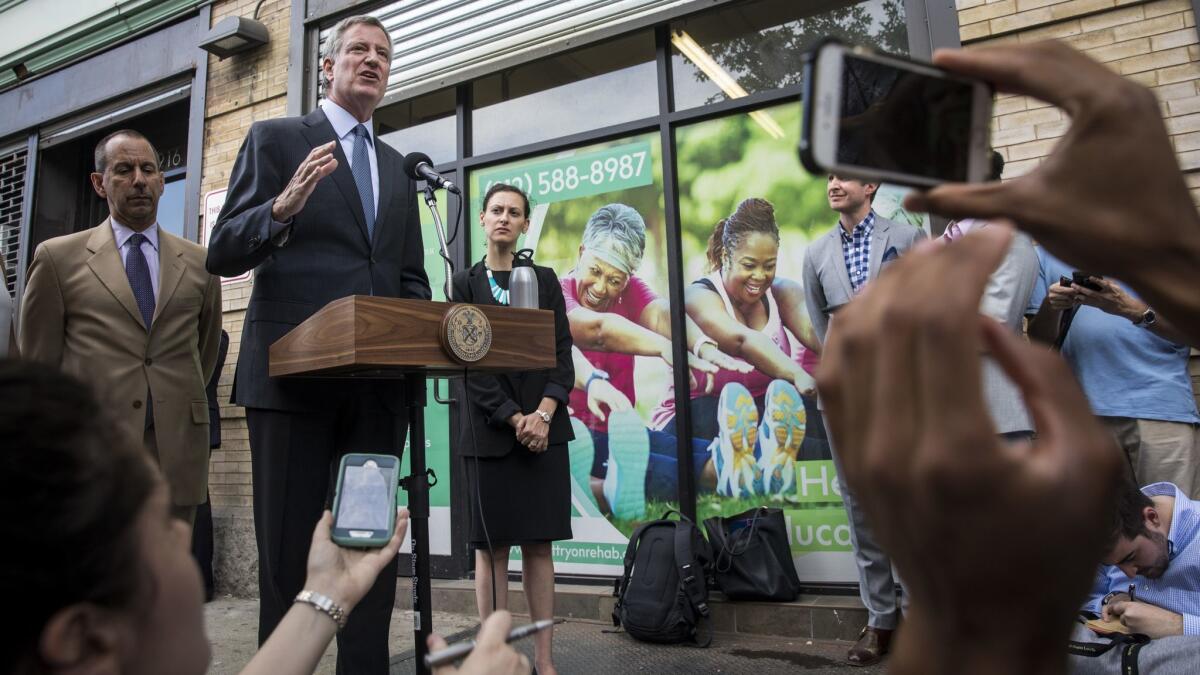What family separation looks like: Guatemalan man is deported, while his 6-year-old daughter remains behind in New York City

- Share via
Six weeks ago Nazario Jacinto-Carrillo left his village in Guatemala with his 6-year-old daughter, Filemona, to seek asylum in the United States, but his plan went awry soon after illegally crossing the California border.
U.S. Border Patrol agents, he said, took his weeping daughter from his arms and told him that she would be returned to him within days.
On Wednesday, Jacinto-Carrillo was deported to Guatemala, but his daughter wasn’t with him. She remains at an undisclosed shelter in New York, where social workers have told the family she cries constantly.
“When I got home my wife and mother were happy to see me, but they were weeping. My wife asked me, ‘Where is Filemona?’” said Jacinto-Carrillo, reached by phone in his village near the city of Huehuetenango.
President Trump on Wednesday abruptly ended his administration’s practice of separating children from their parents at the border, but now the administration faces another test that will likely fall under intense scrutiny: What to do with the 2,300 or so children who have been sent to shelters all over the country.
Officials at the Department of Health and Human Services, the agency that takes custody of children separated from their parents, have said that the children will not be reunited while their parents remain in custody. But reunification demands will increase as more parents are released from detention centers and deported in the coming months at the end of their criminal and immigration proceedings.
That scenario will place the spotlight on the federal government’s ability to reunite the families, a tough task even in the best of circumstances. While taking a child from a parent is swift, the process of reconnecting them is long, legally complex and logistically challenging, a task made more difficult by bureaucratic tangles across various federal agencies.
Parents and children are placed on separate legal tracks, with parents falling into the custody of U.S. Customs and Border Protection or Immigration and Customs Enforcement and children going to the Department of Health and Human Services Office of Refugee Resettlement.
Officials at the agencies did not respond to requests for comment. In a recent statement, Homeland Security officials said that the government is “committed to and has procedures in place to connect family members after separation so adults know the location of minors and have regular communication with them.”
But migrant and human rights groups say there is no formal process that reconnects children with their parents and the problems are compounded because of the lack of coordination among federal agencies.
“Neither ICE or CBP view it as their job to help the families get back together,” said Eleanor Acer, a senior director at Human Rights First, a nonprofit organization that represents asylum seekers. “This is just another example of why these policies are so horrific … Not only are these policies designed to be used to punish people seeking refugee protection, but clearly ill-conceived and poorly managed as well.”
Most parents separated from their children are still incarcerated in the U.S., either in criminal or immigration proceedings. But increasing numbers are being deported and forced to navigate the bureaucratic hurdles and legal complexities of reunification from thousands of miles away.
The path to reunification for many children goes through immigration courts where judges are asked to approve “voluntary departures,” according to immigration attorneys. That clears the way for ICE to transfer a child to their home countries.
The process can take months, and most children, until recently, were placed in the care of family members in the U.S. But such sponsors, often undocumented migrants themselves, are increasingly reluctant to help, advocates say. That is due to a federal guideline announced earlier this year that allows information sharing between the refugee agency and ICE.
Many sponsors now fear that the background information, including place of residence, required by the resettlement agency will be given to ICE agents seeking to deport them.
“Rather than let these families live together, now we’re detaining the newcomers and putting people at risk if they come forward [as sponsors],” said Bardis Vakili, an ACLU attorney based in San Diego.
In Guatemala, Jacinto-Carrillo’s family members say they are desperate to see Filemona. The stress of her absence, Jacinto-Carrillo said, hit him as soon as he entered his front door.
“I felt light-headed and had trouble breathing,” said Jacinto-Carrillo, 32, who was treated medically for his elevated stress levels.
Jacinto-Carrillo and his wife, Marcela Velasquez-Gregorio, 24, are impoverished, illiterate potato farmers who live in a mountain village about two hours from the nearest town in the highlands of western Guatemala. They also have a 2-year-old son.
Though they have cellphones, they can’t afford to make international calls. The bus to the closest town only comes twice a week. The only information the family has received about Filemona has come from a social worker.
They know Filemona is living in a foster home setting somewhere in the New York City area, and that her fits of crying at times cause her to vomit. They say Filemona turned 6 at the shelter.
“My daughter is very sad and crying too much,” Velasquez-Gregorio said. “I wanted to call her on her birthday, but I couldn’t.”
Jacinto-Carrillo said he left Guatemala because he was threatened by gangs, but he reconsidered his asylum claim after crossing the border east of San Diego on May 16.
The Border Patrol agents who took his daughter said that she would be returned to him after he was criminally prosecuted for illegally crossing the border.
“My daughter was screaming and crying and so was I,” Jacinto-Carrillo said.
Thirteen days later, after pleading guilty to the misdemeanor charge, he was transferred to the Otay Mesa Detention Center in San Diego to pursue his asylum claim. Filemona wasn’t there; she had been taken to the shelter.
“Nazario seemed sad, scared and honestly, broken,” said James M. Chavez, his criminal defense attorney, who visited several times during his legal proceedings.
Erika Pinheiro, Jacinto-Carrillo’s immigration attorney, said she will petition an immigration judge to approve Filemona for a voluntary departure. That would clear the way for ICE to transfer her to Guatemala, where social workers could reunite the family. The process could take weeks or months, Pinheiro said.
Jacinto-Carrillo said he still worries that gangs will target him, but he opted against seeking asylum because he wanted to see his daughter again. Jacinto-Carrillo said ICE agents told him that he should agree to be deported so he could be quickly reunited with her.
“What I have fear for is being imprisoned here in the U.S. because my child is alone in New York,” he said he told the agents.
Jacinto-Carrillo, in his court declaration, gave the following statement: “After being in jail for two weeks and having my daughter taken away from me, I decided that the United States is not a place that would protect me.”
More to Read
Sign up for Essential California
The most important California stories and recommendations in your inbox every morning.
You may occasionally receive promotional content from the Los Angeles Times.











